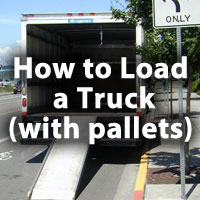How to Load a Truck With Pallets – Video Transcript
Hello and welcome to Premier Handling Solutions’ video series on running a safer and more efficient warehouse. Last week we taught you how to load a pallet. Today we’re going to talk about how to load a truck with pallets and how to unload them as well.
Evaluate Your Container
The main objective for any cargo load is maximize the product inside the trailer without causing the trailer to be overweight as well as eliminating the risk of the load shifting during transportation. Carefully planning your load orientation is the most critical part of the entire process.
As we discussed in last week’s video, the unofficial standard pallet size in the United States is 40” wide and 48” long. The majority of material handling equipment and tractor trailers can hold many variations of load sizes, but are ideal for the 40” by 48” pallet load.
Most semi trailers in the United States are 8’ and 6” wide, 14’ tall, and 53’ long. This trailer size is suited for multiple loading styles and pallet placements.
First, determine the maximum weight allowed by the tractor-trailer and the weight of your load. You can then figure the amount of cargo you can load on the trailer. Being overweight is hazardous for the truck driver as well as others on the road and can result in hefty fines.
After the weight is determined, you can begin planning the load orientation. You must place the loads within the trailer in a manner that will balance the front and rear of the trailer as well as on either side. Make sure each load is situated as tight as possible to ensure the load will remain stable throughout the entire trip.
The three main orientations for loading pallets are:
Side-by-side – This is simply loading the pallets with the short ends facing forward and backward.
Turned – Long sides facing forwards and backwards
Pinwheeled – Half of the pallets are turned
Since the planning process can be difficult, you can take advantage of several helpful tools such as the Pallet Loading Calculator by Packer 3d.
Loading the Trailer
Now that you have an idea of your load orientation, you can begin loading your cargo. You can use any variation of pallet jack or forklift. When using a forklift, always practice proper forklift loading techniques.
First, load the pallet onto your pallet jack or forklift. This is a good time to do a final visual inspection of the palletized load.
Second, begin moving pallet loads into the container. Take the time to ensure your load will match the orientation you had planned.
Finally, finish filling the container with the remaining cargo.
And that’s all there is to it! The container is ready to be closed and transported! These instructions focused primarily on a tractor-trailer container. The dimensions of boat and plane containers vary from truck containers but the basic principles still apply.
Thank you for stopping by to watch the Premier Handling Solutions video series on running a safer and more efficient warehouse. Remember, plan each load carefully to ensure proper balance in the container. Be sure to stop by often for more warehouse tips!

